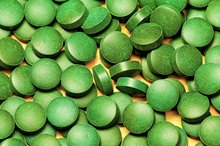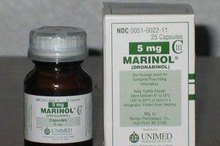What Are Prescription Drugs That Are a Substitute for Marijuana?
Marijuana contains several chemicals including the potent psychoactive substance tetrahydrocannabinol, or THC. The positive effects of THC include pain relief and appetite stimulation. However, negative side effects also exist including disorientation and altered perception. Use of the cannabis plant remains controversial since it is illegal. However, the last few decades have found medicinal benefits of using this drug to treat symptoms associated with cancer and HIV. Prescription versions of synthetic THC exist, ideally offering the same benefits as the marijuana plant. According to the federal Drug Enforcement Agency, the prescription alternatives offer a safer means for treating targeted symptoms.
If you are experiencing serious medical symptoms, seek emergency treatment immediately.
Dronabinol
The Food and Drug Administration approved the use of dronabinol capsules in 1985. Comparatively, dronabinol contains similar active ingredients present in the plant version of marijuana. Initially this medication had use for treating nausea and vomiting associated with cancer chemotherapy. In late 1992, the FDA found additional use for this drug in treating symptoms associated with HIV/AIDS weight loss from lack of appetite. Much like marijuana, this medication has side effects including anxiety, elevated mood and unusual thoughts. A 2004 study reported in Neuro Endocrinology Letters concluded that cannabinoid properties like that in dronabinol have significant therapeutic benefits for treating symptoms associated with other disorders of the central nervous system 1.
- The Food and Drug Administration approved the use of dronabinol capsules in 1985.
- In late 1992, the FDA found additional use for this drug in treating symptoms associated with HIV/AIDS weight loss from lack of appetite.
Nabilone
Cons of Medical Marijuana
Learn More
In 2006 the FDA approved a synthetic cannabinoid called nabilone. This drug is not considered a natural botanical, which is why the FDA did not approve nabilone in 1985 when it was originally introduced. Nabilone is taken as a capsule to treat nausea and vomiting associated with cancer treatment. Nabilone has similar side effects to marijuana use such as confusion, drowsiness and elevated mood. The U.S. National Library of Medicine warns that this drug has the potential for abuse and psychological dependence 23.
- In 2006 the FDA approved a synthetic cannabinoid called nabilone.
- This drug is not considered a natural botanical, which is why the FDA did not approve nabilone in 1985 when it was originally introduced.
Ongoing Research
Dronabinol and nabilone, currently are the only FDA approved prescriptions available as substitutions for marijuana. Ongoing research reported in the "Journal of Neuroscience" in 2005, indicates potential future synthetic cannabinoids with a possibility for medical use. The cannabinoid research is focusing on a drug currently titled WIN55, similar to THC but with a different chemical structure and HU-210, a more potent synthetic to THC with extended duration of action.
- Dronabinol and nabilone, currently are the only FDA approved prescriptions available as substitutions for marijuana.
- The cannabinoid research is focusing on a drug currently titled WIN55, similar to THC but with a different chemical structure and HU-210, a more potent synthetic to THC with extended duration of action.
Related Articles
References
- Neuro Endocrinology Letters: Pharmacology of Cannabinoids 2004
- U.S. National Library of Medicine: Nabilone
- U.S. National Library of Medicine: Dronabinol
- Atakan Z. Cannabis, a complex plant: Different compounds and different effects on individuals. Ther Adv Psychopharmacol. 2012;2(6):241-254. doi:10.1177/2045125312457586
- Hadland SE, Levy S. Objective testing: Urine and other drug tests. Child Adolesc Psychiatr Clin N Am. 2016;25(3):549-565. doi:10.1016/j.chc.2016.02.005
- U.S. Food and Drug Administration. Lung injuries associated with use of vaping products. Updated April 13, 2020.
- Pavlovic R, Nenna G, Calvi L, et al. Quality traits of "cannabidiol oils": Cannabinoids content, terpene fingerprint and oxidation stability of European commercially available preparations. Molecules. 2018;23(5):1230. doi:10.3390/molecules23051230
- National Center for Complementary and Integrative Health. Cannabis (marijuana) and cannabinoids: what you need to know. Updated November 2019.
- National Institute on Drug Abuse. What are marijuana's effects?. Updated July 2020.
- Malone DT, Hill MN, Rubino T. Adolescent cannabis use and psychosis: Epidemiology and neurodevelopmental models. Br J Pharmacol. 2010;160(3):511-522. doi:10.1111/j.1476-5381.2010.00721.x
- Crippa JA, Guimarães FS, Campos AC, Zuardi AW. Translational investigation of the therapeutic potential of cannabidiol (CBD): Toward a new age. Front Immunol. 2018;9:2009. doi:10.3389/fimmu.2018.02009
- Rocchetti M, Crescini A, Borgwardt S, et al. Is cannabis neurotoxic for the healthy brain? A meta-analytical review of structural brain alterations in non-psychotic users. Psychiatry Clin Neurosci. 2013;67(7):483-92. doi:10.1111/pcn.12085
- National Institutes on Drug Abuse. Is marijuana addictive? Updated July 2019.
- Mehmedic Z, Chandra S, Slade D, et al. Potency trends of Δ9-THC and other cannabinoids in confiscated cannabis preparations from 1993 to 2008. J Forensic Sci. 2010;55(5):1209-1217. doi:10.1111/j.1556-4029.2010.01441.x
- Chouvy PA. Cannabis cultivation in the world: Heritages, trends and challenges. EchoGéo. 2019;(48). doi:10.4000/echogeo.17591
- Leal-Galicia P, Betancourt D, Gonzalez-Gonzalez A, Romo-Parra H. Breve historia sobre la marihuana en Occidente [A brief history of marijuana in the western world]. Rev Neurol. 2018;67(4):133-140.
- Drug Policy Alliance. The drug war, mass incarceration and race. Published January 2018.
Writer Bio
Aubri John has been a contributing researcher and writer to online physical and mental health oriented journals since 2005. John publishes online health and fitness articles that coincide with her licensed clinical skills in addictions, psychology and medical care. She has a master's degree in clinical social work and a Ph.D. in health psychology.









